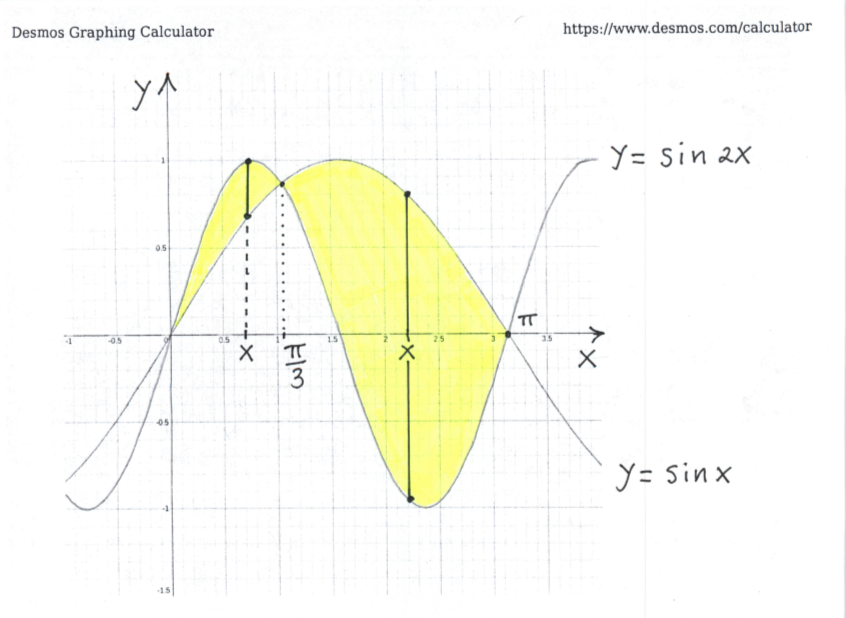SOLUTION 15: Compute the area of the
region enclosed by the graphs of the equations $ y=\sin x $ and $ y=\sin 2x $ on the interval $[0, \pi] $. Begin by finding the points of
intersection of the two graphs. From $ y= \sin x $ and $ y=\sin 2x $ we get that
$$ \sin x = \sin 2x \ \ \longrightarrow $$
$$ \sin x - \sin 2x = 0 \ \ \longrightarrow $$
(Recall the double-angle trigonometry identity $ \ \sin 2x = 2 \sin x \cos x $.)
$$ \sin x - 2 \sin x \cos x = 0 \ \ \longrightarrow $$
$$ \sin x (1- 2 \cos x ) = 0 \ \ \longrightarrow $$
$$ \sin x =0 \ \ or \ \ 1- 2 \cos x = 0 \ \ \longrightarrow $$
$$ \sin x =0 \ \ or \ \ \cos x = \displaystyle\frac{1}{2} \ \ \longrightarrow $$
$$ x = 0, x= \pi \ \ or \ \ x=\displaystyle\frac{\pi}{3} $$
Now see the given graph of the enclosed region.

Using vertical cross-sections to describe this region, which is made up of two smaller regions, we get that
$$ 0 \le x \le \displaystyle\frac{\pi}{3} \ \ and \ \ \sin x \le y \le \sin 2x $$
in addition to
$$ \displaystyle\frac{\pi}{3} \le x \le \pi \ \ and \ \ \sin 2x \le y \le \sin x \ , $$
so that the area of this region is
$$ AREA = \displaystyle{ \int_{0}^{\pi/3} (Top \ - \ Bottom) \ dx +
\int_{\pi/3}^{\pi} (Top \ - \ Bottom) \ dx } $$
$$ = \displaystyle { \int_{0}^{\pi/3} \Big( \sin 2x - \sin x \Big) \ dx
+ \int_{\pi/3}^{\pi} \Big( \sin x - \sin 2x \Big) \ dx } $$
$$ = \displaystyle { \Big( - \frac{1}{2} \cos 2x - \Big( - \cos x \Big) \Big) \Big\vert_{0}^{\pi/3}
+ \Big( - \cos x - \Big( -\frac{1}{2} \cos 2x \Big) \Big) \Big\vert_{\pi/3}^{\pi} } $$
$$ = \displaystyle { \Big( \Big( - \frac{1}{2} \cos \frac{2\pi}{3} + \cos \frac{\pi}{3} \Big)
- \Big( - \frac{1}{2} \cos 0 + \cos 0 \Big) \Big)
+ \Big( \Big( - \cos \pi + \frac{1}{2} \cos 2\pi \Big)
- \Big( - \cos \frac{\pi}{3} + \frac{1}{2} \cos \frac{\pi}{3} \Big) \Big) } $$
$$ = \displaystyle { \Big( \Big( - \frac{1}{2} \Big( -\frac{1}{2} \Big) + \frac{1}{2} \Big)
- \Big( - \frac{1}{2} \Big( 1 \Big) + 1 \Big) \Big)
+ \Big( \Big( - \Big( -1 \Big) + \frac{1}{2} \Big( 1 \Big) \Big)
- \Big( - \frac{1}{2} + \frac{1}{2} \Big( \frac{1}{2} \Big) \Big) \Big) } $$
$$ = \displaystyle { \Big( \frac{1}{4} + \frac{1}{2} + \frac{1}{2} - 1 \Big)
+ \Big( 1 + \frac{1}{2} + \frac{1}{2} - \frac{1}{4} \Big) } $$
$$ = 2 $$
Click HERE to return to the list of problems.

